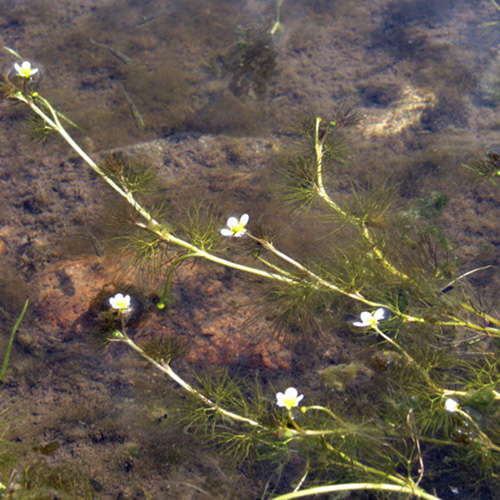Plant of the Week
 Range map of Ranunculus aquatilis. States are colored green where the species may be found.
Range map of Ranunculus aquatilis. States are colored green where the species may be found.
 Ranunculus aquatilis, flowers sitting just above the water’s surface.
Ranunculus aquatilis, flowers sitting just above the water’s surface.
 Ranunculus aquatilis, flowering plant showing submerged leaves. Photo by Danielle Walkup & Bill Norris
Ranunculus aquatilis, flowering plant showing submerged leaves. Photo by Danielle Walkup & Bill Norris
 Ranunculus aquatilis stem and leaves. Photo by Robert W. Freckmann
Ranunculus aquatilis stem and leaves. Photo by Robert W. Freckmann
White Water Crowfoot (Ranunculus aquatilis L. var. diffusus With.)
By Melissa Simpson, Ecologist, Chequamegon-Nicolet NF
Ranunculus aquatilis var. diffuses, white water crowfoot, is found throughout North American, north of Mexico and in Eurasia and Australia. It is a perennial aquatic plant with finely-dissected, fan-shaped leaves with an alternate arrangement along the stem. The leaves are all submerged and a solitary, white, 5-parted flower sits just above the water’s surface, blooming April-September throughout its range. The leaves may be stiff with no petiole (holds its shape when held out of the water) or very delicate with a petiole (goes limp when held out of the water). Some sources separate the stiff form as R. longirostris and the limp form with a petiole as R. trichophyllus. They produce small, beaked fruits or nutlets that form clusters on slender stalks.
White water crowfoot grows in lakes or slow moving water up to 2 meters in depth. Ranunculus is from Latin rana, meaning "little frog," because many species tend to grow in moist places and aquatilis, meaning growing in or near water. The fruits are a source of food for some waterfowl and the submerged vegetation provides shelter for fish and aquatic invertebrates.
Members of the Buttercup Family (Ranunculaceae) contain a toxic compound called protoanemonin. This compound is released when the plant is wounded, for example, when you pick it or an animal chews it. Plant juices can cause skin irritation and blistering. If swallowed, it can cause burning of the mouth and digestive tract, as well as nausea, vomiting and convulsions. The plant is most poisonous when it is flowering or experiencing vigorous growth. Luckily, due to its nasty nature and acrid taste, animals stop eating it and usually don’t ingest enough to cause significant internal damage or death. Gardeners and wildflower enthusiasts should wear gloves and exercise caution when working with buttercups, including white water crow foot. Dried plant material is usually harmless.

